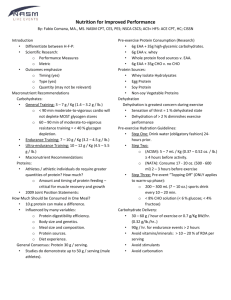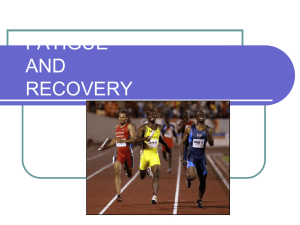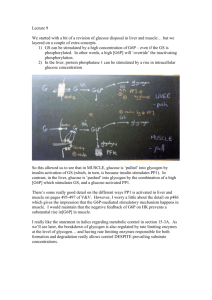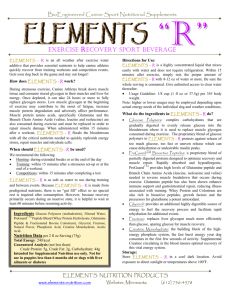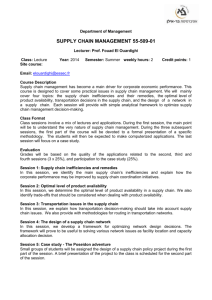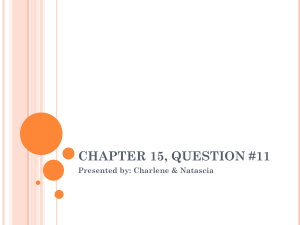Carbohydrate Intake and Athletic Performance
advertisement
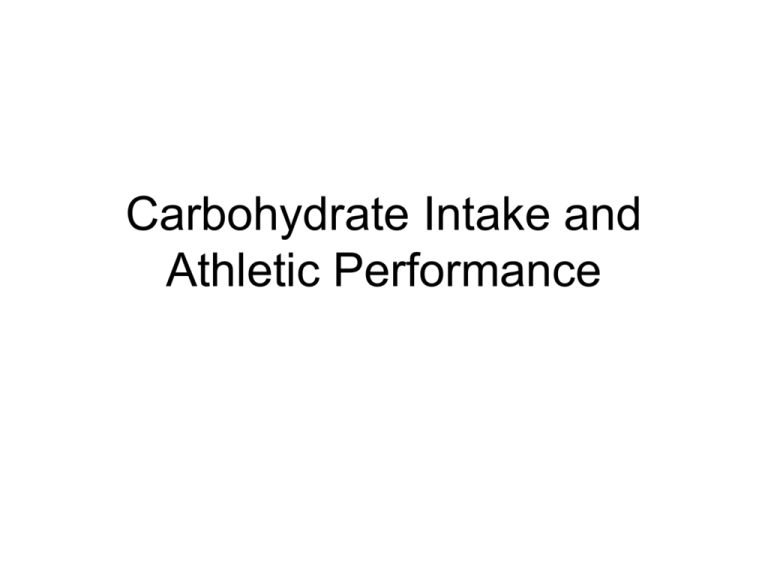
Carbohydrate Intake and Athletic Performance How much carbohydrate do athletes need to eat? What do you need the CHO for? At rest, brain/nerve cells use about 7 grams/hr= 150g but 50% from gluconeogenesis so need to eat 75g Other use (muscle cells, fat cells, etc. using glucose after a meal) plus general “out and about”= 125-150g Total = about 200-225 grams Physical activity: 30 minutes of easy walking = about 25 grams 45 minutes of moderate running = about 75 grams 60 minutes of hard running = 125 grams 120 minutes of interval running = 200 grams How much CHO do we have in our bodies? An average 70 kg male has 1500-1600 kcal of CHO stored in the liver and muscle glycogen and circulating blood glucose. Muscle: 1200 kcal = 30g Liver: 320kcal = 80g Blood Glucose: 20 kcal = 5g So, athletes need to consume approximately: 225g + (100-300g) = 325-625g CHO The daily recommended intake for athletes is 5-10 g of CHO per kg of body weight. Ex: 70 kg = 350-700g CHO (1400-2800 kcal) This is 60% of a 2500 kcal - 5000 kcal diet (athlete in training). Sources of Carbohydrate Monosaccharide: Glucose, fructose, galactose Disaccharides: Table sugar: sucrose Milk sugar: lactose Corn syrup: glucose/fructose Complex Carbohydrates: STARCH-plants store extra CHO in the form of starch. High Glycemic Index CHO = enters the blood from the gut quickly. They are easy to digest/ absorb and enter the circulation within minutes. Ex: Source g/serving Gatorade 8oz=14g Cornflakes 3/4cup=25g Honey 1tbsp=15g Low/Mod GI CHO = enter the bloodstream more slowly. They must be broken down first by digestive enzymes before being absorbed. (generally have a higher fiber content). MOD Rice Pasta Banana 1cup=45g 1cup=40g 1med=25g LOW Apple Choc milk Yogurt 1med=20g 8oz=25g 1cup=50g CHO Intake Fuels Exercise • The average American consumes 45% of their daily calories as CHO. 60% seems like a lot! CHO intake influences liver and muscle glycogen stores. • Glycogen levels affect endurance performance. – Decreased glycogen hasn’t shown a decrease in performance time but does show increases in the perception of fatigue. • Runners consuming 40% of energy from CHO could not replenish muscle glycogen on a daily basis whereas runners on a 70% CHO diet could. (Costill et al.) Costill et al. CHO Intake Before an Event So if CHO is good, is more better? Is there any evidence in the literature that increasing CHO consumption will increase muscle glycogen levels? And, if you increase your glycogen stores, does this have any impact on performance? How do athletes increase their muscle glycogen stores? Supercompensation involves “swelling” muscle glycogen by changing diet and exercise patterns several days before a major competitive event. • 2 techniques: 1. depletion/repletion 2. Modified moderate approach 1. Depletion/repletion: - depleting glycogen reserves as much as possible through a combination of an extremely long bout of exercise about 7-10 days prior to a major competition, followed by a few days on a very low-CHO diet. Another bout of exercise on the 4th day and then 3 days of a high CHO diet. • Muscle glycogen stores can be greatly increased, often by as much as 50% over the usual “full” condition (e.g. from 300 over 400 grams). • If it costs 100 kcal to run a mile, and 60% of energy comes from muscle glycogen = 60 kcal of glycogen mile = 15 g glycogen needed /mile. If you start with 300 grams you can run 20 miles before running out. • If increase to 400g, can extend run to 26.5 miles. 2. More popular approach is to taper training the week before competition while increasing the %CHO in diet (e.g. from 50-60% up to 70-75%). • Although increases in muscle glycogen are not as dramatic as with the depletion/repletion approach, increases of perhaps 20% are possible (300g 350g) Benefits from CHO loading: Increases time to exhaustion Reduces the time to complete a task (time trial; endurance by 2-3%) May improve performance in team sports that involve intermittent exercise and skill executions. The downside to CHO loading/muscle glycogen supercompensation: Only good for a one-time ultra distance event (marathon). A cyclist riding over several days would not see benefits...consecutive competition days are not improved with this protocol. Every gram of CHO is stored with 3g of water. This means that the storage of 500g of CHO is accompanied by a water weight gain of approximately 2kg. This would not be good for sports where an increase in body mass is not desirable. CHO intake before exercise Goal: maxmize exercise performance 3-5 hours: this is usually • Remember that the breakfast liver glycogen is used to: - Large meal to – Maintain blood replenish liver glucose levels (it’s the glycogen brain food) - Increase muscle – It’s decreased after an glycogen stores overnight fast. – It’s decreased by 50% after an hour of exercise at 75% VO2max. 60-30 minutes before exercise... • Top off liver glycogen • Increase blood glucose levels, can be used as a substrate during exercise...or if intensity is low enough it will be used to synthesize muscle glycogen. Common belief: ingesting High GI CHO right before exercise will create rebound hypoglycemia and decrease performance. Why? Rebound Hypoglycemia Hypoglycemia: - Dizziness, nausea, cold sweat... - - Insulin release stimulated by glucose promotes skeletal muscle glucose uptake. Exercise (muscle contractions) also stimulate glucose uptake...both are working... Galactose Decreased mental alertness Decreased motor skills Placebo 9 Glucose 8 - Increased HR - Hunger - Disorientation Glucose (mM) 7 6 5 4 3 2 1 0 0 15 30 45 60 70 80 90 100 110 120 135 150 165 180 TIME (min) There is little evidence to support this hypothesis that performance is decreased... However, two strategies are widely used to prevent rebound hypoglycemia in athletes. 1. 2. Consuming lower GI CHO one hour before exercise If high GI CHO is consumed right before or at the onset of exercise, then there seems to be a benefit to maintaining carbohydrate intake during exercise. “once on gatorade-stay on gatorade” CHO during Exercise CHO consumption during exercise >45min can improve performance. How? 1. Maintain blood glucose and CHO oxidation rates. 2. Spares liver glycogen. 3. Synthesizes muscle glycogen during LOW intensity exercise 4. Increases motor skills in prolonged periods of play. 5. “Feel better” later into the exercise bout. How much should I consume? - 1.2g per minute, 70g/hour during endurance exercise... What should I drink? glucose polymer (gatorade=good) galactose,fructose-not so good, must first be converted to glucose by the liver to be used as a substrate. The delivery rate from the gut to the muscle tissue is 1.0g/min, as intensity increases blood flow to the digestive system decreases and there is a greater reliance on muscle glycogen as a fuel source. Choose drinks ranging from 4-8% CHO. Drinks with too much CHO (coke has 11.25% CHO) will not be absorbed as efficiently and could cause stomach upset. Remember that CHO replacement during exercise is not generally needed for activities lasting less than 90 minutes. CHO after exercise... GOAL: To replenish muscle glycogen The rate of glycogen synthesis depends on glucose transport to the muscle and the enzymes involved in glycogen synthesis. Exercise increases: - GLUT 4 (transporters) - glycogen synthase There are two phases of muscle glycogen replenishment after post-exercise CHO consumption: Rapid (not dependent on insulin-but enhanced) Slow (>3hrs, insulin dependent) CHO after exercise... • Factors affecting glycogen synthesis: – Timing • When CHO is delayed two hours muscle glycogen is 45% lower compared to immediate consumption of the same amount. – Rate of ingestion (amount): 0.7-1.0g CHO/kg consumed every two hours – Type (High GI, vs. Low GI): High GI, large insulin release, more CHO storage – Combo with protein Glycogen Synthesis Once CHO needs are met, the effect of protein supplementation does not enhance muscle glycogen storage. Glycogen synthesis relative to control 300 200 100 % 0.8 g/kg/hr 0.8 g/kg/hr 1.2 g/kg/hr 1.2 g/kg/hr CHO CHO+PRO CHO CHO+PRO What do I do if rode 35 miles and left my $2 drink and $3 bar at home? The key to optimal recover is to create a hormonal environment that is anabolic and provides the necessary raw materials. Eating foods high in CHO provides glucose and also stimulates a large insulin response that facilitates entry of glucose into cells and its storage as glycogen. Maximizing the amount of glycogen stored depends on both the quantity of CHO and the insulin response: in the short-term (first 2-6 hours) there does appear to be an advantage to consuming simple sugars rather than complex CHO because the insulin response is greater. Strength and Power Athletes • We know CHO is great for increasing endurance performance but what about strength and power athletes, do they need CHO the same way? – Higher intensity activities use muscle glycogen as a fuel source so adequate glycogen is necessary for performance. – Glycogen super-compensation does not appear to increase performance once a certain intensity is reached. – Supplementation is most advantageous for athletes involved in high intensity training regimes where time between sessions is limited <20hours.
